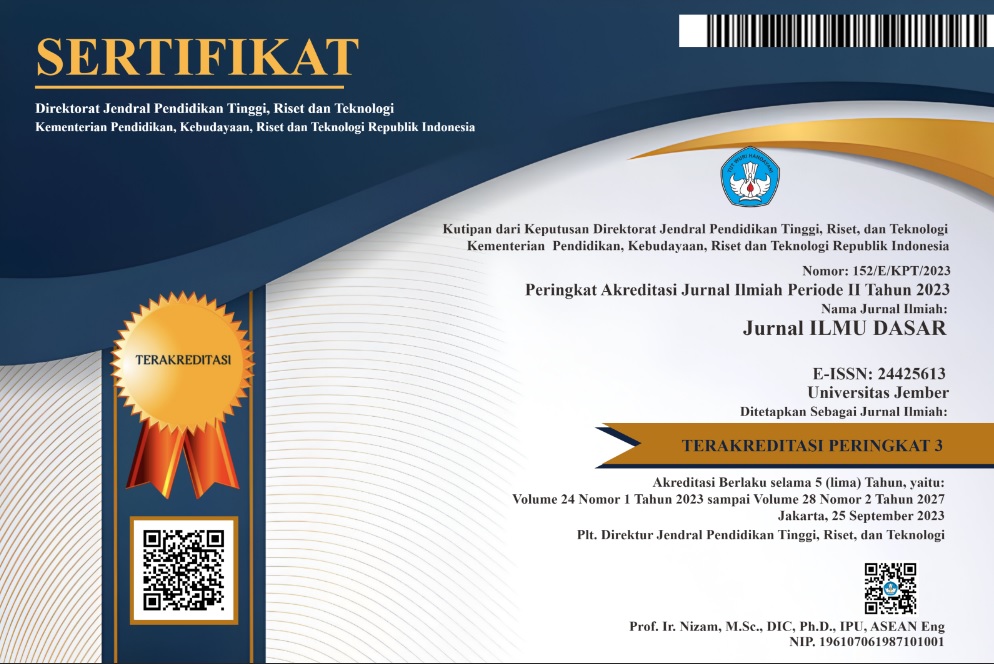Construction of Three Branches Fractal Trees Using Iterated Function System
DOI:
https://doi.org/10.19184/jid.v23i1.17447Keywords:
fractals, fractal tree with three branches, Iterated Function System, affine transformationAbstract
There are two types of fractal: natural fractals and fractals set. The examples of natural fractals are trees, leaves, ferns, mountain, and coastlines. One of the examples of fractals set is Pythagorean tree. In the earlier study, the Pythagorean tree has two branches generated through several affine transformations, i.e dilation and rotation. Here, we developed the Pythagorean tree (or fractal tree) with three branches through dilation, translation, and rotation transformation using Iterated Function System (IFS) method. Some values of height and length parameters were selected to ensure the formation of a fractal tree. These parameters affected the branching angle that can result in different fractal tree shape. Some random values of height and length parameters produced several variations of fractal tree. These values influenced the shape of fractal whether it tended to the left, to the right, or symmetrical shape.
Downloads
References
Beck, F., 2015. Generalized Pythagoras Tree: A Fractal Approach to Hierarchy Visualization. International Joint Conference on Computer Vision, Imaging and Computer Graphics. 115-135.
Browne, C., 2007. Efficient Pythagorean trees: Greed is good. Computers & Graphics. 9(1): 111-124.
Hasang, S., Suparjo, S. 2012. Geometri Fraktal dalam Rancangan Arsitektur. Media Matrasain. 9(1): 111-124.
Kusno. 2003. Geometri Rancang Bangun Studi Surfas Putar Transformasi Titik dan Proyeksi. Jember: Fakultas MIPA Universitas Jember.
Matam, S. 2012. Pythagoras Trees. https://www.codewalk.com/2012/01/ pythagoras-trees.html. [29 Mei 2019]
Navarro, C.F., Garcia, J.C., Tavares, M.M. 2014. Main Objects of Fractal Geometry and Computer Graphical Generation, Research Journal of Computation and Mathematics; 2(2): 14-26.
Prasasti, I. 2018. Pemanfatan Metode Iterated Function System Dalam Pengembangan Motif Anyaman. Skripsi. Jember: Jurusan Matematika FMIPA Universitas Jember.
Purnomo, K.D. 2014. Pmbangkitan Segitiga Sierpinski dengan Transformasi Affine. Prosiding Seminar Nasional Matematika Jurusan Matematika FMIPA Universitas Jember. 365-375.
Sharma, R., Kokane, D.N.. 2015. Pythagorean Tree Multiband Fractal Antenna. International Journal of Engineering Research and General Science. 3(5): 1031-1035.
Teia, L., 2015. Pythagoras’ triples explained by central squares. Australian Senior Mathematics Journal. 29(1): 7-15.
Teia, L., 2016. Anatomy of the Pythagoras’ tree. Australian Senior Mathematics Journal. 30(2): 38-47.
Ubaidillah, F., Purnomo, K.D., Sundusia, J.K. 2019. Pembangkitan Fraktal Pohon Pythagoras Menggunakan
Iterated Function System. Prosiding Seminar Nasional Integrasi Matematika dan Nilai Islam. 3(1): 55-60.
Van der Laan, K. 2013. Pythagoras Trees in PostScript. https://www.ntg.nl/maps/44/06.pdf [28 Mei 2021].








